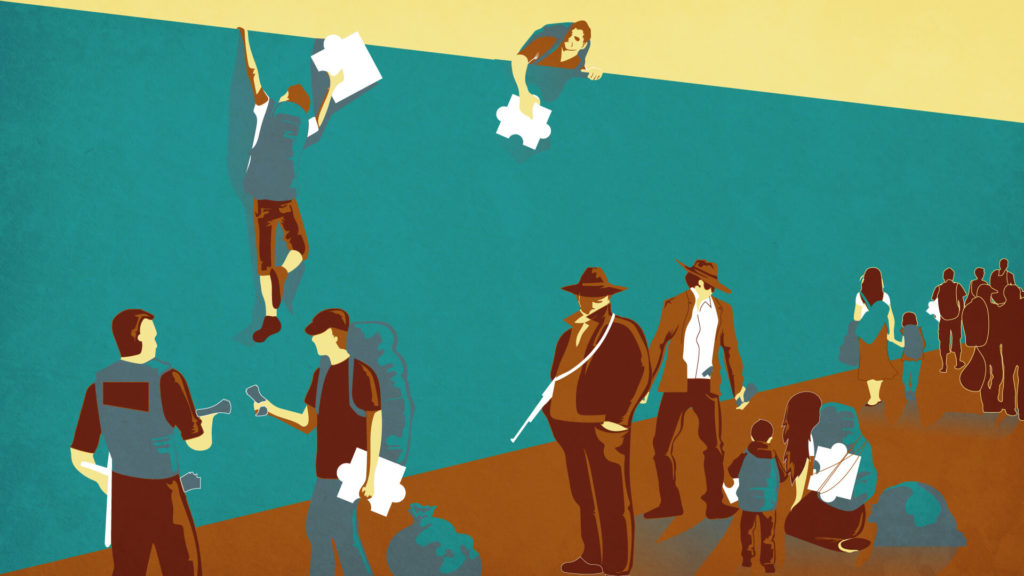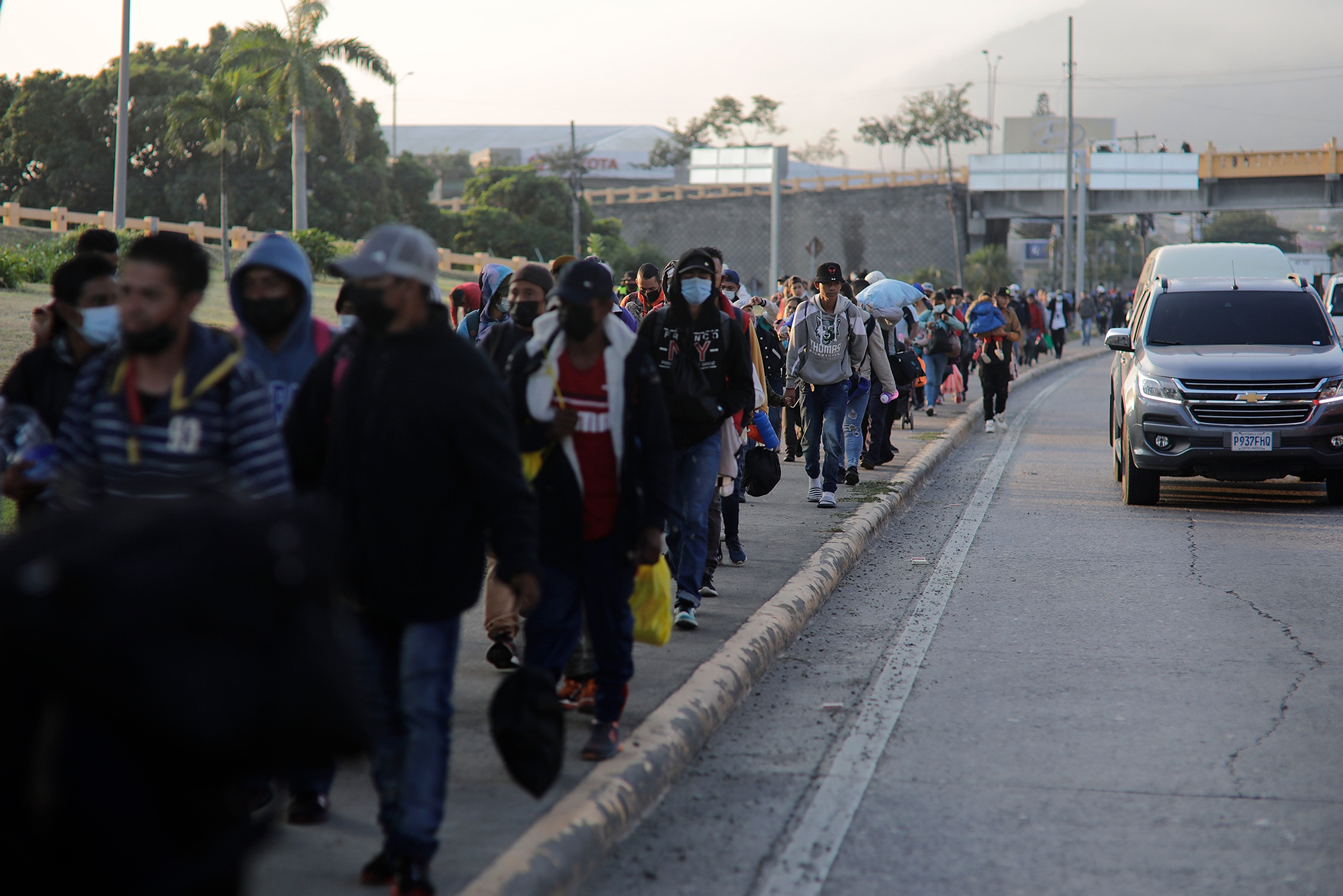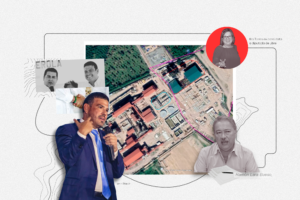To understand the mass emmigration of the Honduran people, we must review the last decade of this country: a coup d’état, a looted and poor country, and a narco-state.
In Lucerna, a small border town in western Honduras, a worker can earn US$36 a week, but in the United States they can earn 22 times that during the same period. The story of being kidnapped, beaten, and abandoned in the desert to achieve the dream of leaving Honduras and living with dignity in a foreign country is a story which is repeated around the country. No fear is worthy of calculated survival.
Written by: Allan Bu
Photographs by: Jorge Cabrera
@ContraC_HN
1. Lucerna
Lucerna is a small town in Ocotepeque in western Honduras, near the El Salvadoran and Guatemalan borders. With dusty streets and modest housing, this town has seen unusual migration in the last four years, which is evident in changes to the town. The old rural houses contrast now with new large houses with modern designs on the roofs, large windows and facades similar to housing in US suburbs.
Most of these houses were built using money sent by migrants who left the town due to the lack of opportunities to live in a dignified way. In Lucerna, a farm laborer earns just 150 lempiras a day (U$7). If they work all week, they would earn 900 lempiras (US$36), but in the United States, they can earn US$700 or 800 in that time. That is why they leave the country.
In 2021, at least 30 young people from the town of Lucerna travelled to the United States, according to information from locals; seven of those migrants were kidnapped in northern Mexico. One of them was Manuel, who in January last year, decided to pack a suitcase and seek out a new life in the US. His 17-year-old son accompanied him on the adventure.
“Sometimes it is because of the lack of work that we make such decisions. It is complicated; we want to see if there is something there,” he says.
With the arrival of the pandemic and the destruction caused by hurricanes Eta and Iota in Honduras, the country lost around half a million jobs, according to estimates by the Honduran Council of Private Enterprise (Consejo Hondureño de la Empresa Privada – Cohep). According to figures from the National Institute of Statistics (Instituto Nacional de Estadísticas – INE) in 2020, the open unemployment rate reached 10.9%, the visible underemployment rate reached 27.3%, and the invisible employment reached 43%.
And 2020 was a ominous year for micro, small and medium enterprises. At least 10% had to shut down indefinitely due to the confinement decreed by the government to contain Covid-19. Before the pandemic, micro, small and medium enterprises provided up to 70% of jobs in the country.
For Honduras, 2020 represented a 10.9% recession, according to estimates by the Central Bank of Honduras (Banco Central de Honduras (BCH). In 2019, the INE noted that the poverty rate was 59%. In 2020, the institute did not provide information in this regard. However, by 2021, the survey applied by the INE showed that poverty had reached 73.6%of Honduran households.
Manuel left the country because of that poverty, and with hard work, he managed to pay a smuggler US$8,000 to help him and his son across the border between the United States and Mexico. Manuel says that on the way, the coyote advised them to turn themselves in to the Border Patrol in order to request asylum. However, when they crossed there was no way to do that, and they were forced to return almost immediately to the border city of Reynosa, in Tamaulipas state.
Manuel wanted to try crossing again. While he was in Mexico he received a call from the coyote, who told him that he was going to pick him up at the Reynosa bridge, which crosses the Rio Grande. However, moments later, when he and his son left the place where they were staying, they were kidnapped.
“The kidnappers watch over the border crossings, and the taxi drivers and even the police are in cahoots with them,” says Manuel, who had to pay another US$4000 for his and his son’s freedom.
Reynosa ranks third for the most registered kidnappings of migrants, according to statistics from the non-profit organization Stop Kidnapping (Alto al Secuestro). Between December 2018 and July 2021, 49 kidnappings were reported, but this figure does not include migrants who did not report to authorities or who did not tell their story to a media outlet. In 2021, the Anti-Kidnapping Unit of the Tamaulipas Attorney General’s Office reported that they had saved 235 migrants, held against their will in Tamaulipas and Miguel Camargo.
Manuel was kidnapped for three days. Those who held him against his will called themselves The Hustlers (Los Mañas), according to what he heard. The Honduran said that at that time there were more than 60 migrants in the warehouse where they were locked up. That figure from a single day exceeds the record of complaints that the Stop Kidnapping organization has received during almost three years.
In order to pay the amount they asked for, he called his wife in Honduras, but she could not send the money as it had to be sent to Mexico in various parts, due to banking restrictions in the country. A friend who lives in the United States lent him US$4,000, which he then had to pay back.
He says those who kidnapped him were not particularly violent, but they were well armed. “They did not hit anyone, but they did not let us out either. They kept us in a field and the migration officials came to rescue us when almost all of us had already paid,” says Manuel.
After the experience, he distrusts the coyote that took him to the border. “It is curious that he picked me up to take me to a warehouse and we only walked a little and he gave us over to other screwed up people,” says Manuel from his house in Lucerna. He built it out of adobe, a material widely used in rural areas of western Honduras. After what happened in Mexico, Manuel went back to working in agriculture.
“I heard stories that the police detained people that the coyotes had hidden waiting to cross, but instead of deporting them they handed them over to criminals. They’re all just one big mob. The crossing in Mexico was perhaps easier before, but now it is difficult,” says Manuel.
Despite fear and being aware of all this, in September 2021, his son headed to the United States again. This time, he managed to get there and quickly found a job.
"They almost kidnapped him again, but he was saved because the coyote divided the group," Manuel says.
2. From the banana field
The children of Don Filiberto, a 57-year-old man, left northern Honduras on September 9, 2021, and headed to the United States. Like thousands of their compatriots, they were seduced by the idea of a job with a better income which would benefit their family. But the dream of the two boys only took one day to become a nightmare. On September 10, the two young ones were kidnapped in the Mexican state of Tabasco.
That day, they were walking along a state highway, when Mexican police officers, who were driving in a patrol car, stopped and told them that if they did not get out of the way they would be arrested, their father says. The frightened youth followed the advice of the authorities and went down a side path, which took them directly to the unidentified criminal group that kidnapped them.
On September 11, after 24 hours, the criminals called Don Filiberto to demand 200,000 lempiras (US$10,000) to save the sons. He remembers that call very well, “I told them: I don’t have money,” he says. The kidnappers sent a video in which the two boys were brutally beaten. “Now finish them off,” the father told a man who had called him. “Is that what you want? Well, tomorrow we’ll kill them,” he replied.
In the first six months of 2020, at least 3,250 migrants suffered attacks such as kidnapping, rape, armed robbery and human trafficking, while they waited for a response to their asylum requests at the Mexico-United States border, according to information collected by the international organization, Human Rights First (HRF).
The organization The Other Side (Al Otro Lado), which works with migrants in the city of Tijuana in Mexico, was consulted for records of kidnappings on the border for this investigation. They responded via email that they did not have a specific number for kidnapped Hondurans, but said that 83% of 20,000 migrants of different nationalities surveyed reported having been victims of some form of violence.
Migrants face various types of aggression on their way to the north. The most well-known of these, and most addressed by the media, is kidnapping, which has become a business that generates billions of dollars, according to Rubén Figueroa, an activist from the Mesoamerican Migrant Movement (MMM).
According to Figueroa, the phenomenon cannot occur without the collaboration of authorities.
“We are not only talking about bribery, but about direct participation in human trafficking,” he says. This consideration coincides with the testimony of kidnapped migrants consulted for this investigation.
In 2015, a report by the Foundation for Justice and the Democratic State (Fundación para la Justicia y el Estado Democrático de Derecho – FJEDD), identified the nationalities of 552 kidnapping victims: 372 Hondurans, 101 Salvadorans, 74 Guatemalans, and 5 Nicaraguans. There were another 609 victims for whom it could only be verified that they were Central Americans. Among the kidnapped people, there were also Ecuadorians, Brazilians and Peruvians. That same report maintains that 55% of the migrants were kidnapped in southern of Mexico; 11% in the north; 1.2% in the center and for 32% it was not possible to specify where they were arrested.
The problem is not new. In August 2010, the news of the murder of 72 Central American migrants in San Fernando, Tamaulipas, put the kidnapping of undocumented migrants on the front pages and, according to a report by United Nations High Commissioner for Refugees (UNHCR), this fact forced the government of Mexico “to recognize the magnitude of the problem of the kidnapping of migrants.”
The massacre was attributed to the Los Zetas Cartel, one of the bloodiest in the region, which focused on drug trafficking, fuel theft and extortion, among other crimes. Today there are small cells throughout the country, kidnapping and extracting thousands of dollars from migrants, who are usually poor.
Don Filiberto says that he watched helplessly as his children were brutally beaten in a video that went viral on social media. After seeing the video, he argued with the kidnappers and the last words he heard were, “Today we kill them.”
“God freed them,” says Don Filiberto. His children tell him that they were beaten for 10 hours and when they fainted, the kidnappers tried to get rid of the bodies. “They did not lose consciousness and heard the criminals say: ‘Lets get some shovels to bury these dogs. No one will send money now,’” says the father.
His children told him that they got up and fled after their kidnappers disappeared. After walking for three days, they managed to reach a house, where they received help, but that day a group of men asking around for two young migrants.The woman who helped them said that she had not seen them and then sent the boys by taxi to the city of Palenque, still in Tabasco, where they were treated at a medical center and spent 15 days recovering in a safe place.
Don Filiberto believes that his children were not kidnapped by a cartel, but rather by thieves from Mexico and Guatemala who had joined forces to commit crimes, “The worst thing is that even if you send money, they always kill them. My children say that they once saw that happen,” he says.
The National Search Commission in Mexico, which has records going back to 1964, states that there are almost 100,000 missing people in that country. Between September 2020 and the end of July 2021, the agency indicates that 6,453 cases were reported. Mexico is a country plagued by violence, with a so-called war on drugs seeing 30,000 murders a year.
For Don Filiberto’s children, the nightmare continued. They regained strength and returned to the United States and crossed the border, but they were arrested by US immigration, which had a request from the Mexican courts to return the two Hondurans to Mexico. “They were beaten again because the officers asked them what they had done for authorities to be looking for them,” says Don Filiberto.
When the case was talked about on social media, the Mexican prosecutor’s office stuck to the law. For this reason, they were arrested at the border, then deported to Mexico, instead of Honduras. The two brothers received a humanitarian visa and began the process of requesting asylum in the United States.
Javier Martínez, a worker at the Migrant House (Casa del Migrante) in Saltillo, Coahuila, says the response by Mexican authorities to crimes against migrants is very bad and according to his calculations, 99% of these cases go unpunished.
“In the work that we do, we have access to complaints and demands for human rights violations. The problem is that it never lands, the complaints never reach a judge,” he says.
He believes that cases are only resolved when they get media coverage. “Otherwise things remain under investigation,” says Martínez.
Don Filiberto tells his story and that of his children from his house in one of the former banana fields in El Progreso, Yoro, in northern Honduras. The region was once the headquarters of the “banana republic,” a term used to describe a poor, corrupt country with little democracy, low-value exports and controlled by foreign interests.
There, where his children grew up, the nostalgia of the banana plantation remains, although it is no longer the same. There are still many export banana plantations, along with the new predominant monoculture, African palm. There are also many stories of young people who left because there was no development thanks to those plantations.
3. Migration: television news
The son of Aminta, a teacher, was kidnapped by Los Zetas. She describes how the young man had to run away from Honduras after receiving a threat from gang members in the neighborhood where he lived in San Pedro Sula, the main city in the north of the country. In an attempt to save his own life, he nearly lost it. Alejandro, as we will call the teacher’s son, was kidnapped twice, but before these events he almost died in a container where nearlly 200 migrants were also travelling.
As if it were a movie, the teacher was able to watch the moment on a US channel when the police opened the container and some of the undocumented migrants almost fainted, but her son headed into scrubland, away from the authorities. That escape was the beginning of the nightmare. “That’s when I knew he was alive,” says the teacher.
Advancing without a coyote, Alejandro almost immediately fell into the hands of the Zetas. At the time, the teacher was at school with her students. She received a call requesting approximately US$4,000. “I’ll need me time,” she said and, as she recalls, they replied, “There’s no time. Get moving, and be careful about talking to the police because we will known.”
Rubén Figueroa of the MMM, argues that criminal groups are currently kidnapping without discriminating. “Everyone is kidnapped, but poor people more so,” he says. Figueroa says that in the past, kidnappers would investigate people and if they had relatives in the United States, they demanded money.
“Migrants who have no relatives in the United States were released after torture and mistreatment. Today criminals try to get water from a stone,” says Figueroa. The activist points out that the most vulnerable people are those without documents, who can’t pay a coyote.
Claudia Pinto, coordinator of the FJEDD office in Honduras, says that since the kidnappings of migrants was documented in 2009, they haven’t stopped happening; however, they are now much more visible. She adds that most of the people who are leaving the country do not have money to pay a trafficker, which makes them more vulnerable. “It is unpleasant to say, but people who pay a coyote pay for a certain amount of security, which others don’t have,” she says.
In the last four years, Honduras has registered unprecedented migration levels, seen in the caravans organized in 2018. They brought up to 15,000 Hondurans together, who walked to the southern border of the United States. The last such huge caravan was in January 2021, when some 7,000 Hondurans attempted to reach Guatemalan territory, but they were stopped there. Between 300 and 500 Hondurans cross the country’s border every day. They do it without registration and without leaving a trace.
So, there is no exact number for the exodus, but according to the United States Customs and Border Protection Service, in 2020, they arrested 40,091 Hondurans who were trying to enter the United States and by September 2021, this amount increased to 98,554 – more than double the previous year.
Aminta, the teacher, explains that she had to use all her savings to pay the ransom demanded by her son’s kidnappers. She sent the money in five parts, because the bank did not allow her to send it in one transaction. After paying, the criminal group arranged for Alejandro and other kidnapped migrants to reach the border.
When they lent the young man a phone to communicate with her, he described what happened. On one occasion, he told her the kidnappers made himself and other migrants who remained captive dig a huge hole without explaining why. “There is no question here, mom. Those of us who paid are calm, but we haven’t seen those who didn’t,” the teacher says her son said.
Once on the border between Mexico and the United States, Alejandro was kidnapped by another criminal group called the Black Scorpions. It had only been a little over a month since the previous kidnapping. Now the ransom was US$5,000.
The teacher had to apply for several loans and was unable to obtain the requested amount immediately. She took about twelve days and during that time, her son was tortured. A video called showed her son tied up and his captors grilling meat. The criminals tortured Alejandro by placing the hot grill on him.
After paying the ransom, the teacher’s son was found in US territory and members of the border patrol help him. He was seriously beaten, his kidneys were badly damaged from the beatings he received and he was transferred to Houston, where he was in a hospital for almost two months. When his health improved, he was deported. In Honduras, he needed a psychologist.
“On the migrant journey, everything is money. The cartels think that migrants carry money and they don't care if they carry money or not. You have to look for it,” says the teacher.
A lack of hope prevails. After the terrorof going through two kidnappings and after many days crying over what he remembered, Alejandro, the teacher’s son, decided to set out again on the road to the United States. This time he succeeded and now has work there.
News of migrant kidnappings abound in the media. However, it seems that the crime is invisible to governments. Claudia Pinto, Honduran coordinator of the Foundation for Justice, points out that she has heard Mexican president Manuel López Obrador say, “Nothing has happened in Mexico.”
“This is very serious because he is evading the state’s responsibility; and abandonment by authorities in Honduras is also serious. They do nothing to coordinate between countries. They are states with structure and could coordinate search and rescue efforts, but this does not happen,” she says.
In Honduras, this crime is also invisible. For this investigation, a request was made through the Law of Access to Public Information, to the Chancellery of the Republic, in order to find out the numbers of migrants who have reported kidnappings. However, they responded that these records were in the Security Secretariat, which coordinates with Interpol. We filed another information request, which also wasn’t responded to.
Further, we attempted to contact the vice chancellor of the previous government, Nelly Jerez, but she did not respond. Lastly, we request information on kidnappings of Hondurans from the Saltillo consulate in Mexico. From this office, they limited themselves to saying that they were forbidden to provide information or interviews.
4. Will they stay to see a change in Honduras?
The exodus does not end. Organizations such as the Pastoral for Human Mobility estimate that between 300 and 500 Hondurans leave the country daily, choosing to flee the violence, organized crime, corruption and climate change. Honduras has an average of 40 deaths per 100,000 inhabitants associated with common violence, organized crime and drug trafficking. That is a high rate for a country that is not technically at war. Many neighborhoods in the main cities are controlled by gangs, though the previous government bagged about its security policy.
Drug trafficking has been linked to the last two presidents of Honduras. Tony Hernández, brother of former president Juan Orlando Hernández; and Fabio Lobo, son of former president Porfirio Lobo, were convicted of drug trafficking by US courts. Former president Hernández was accused of having links to drug trafficking in the trials against his brother and Giovanni Fuentes Ramírez. Now the US has requested his extradition and he is being detained in the buildings of the Special Forces of the National Police. A sentencing judge has already granted the extradition, but the defense will appeal to the Supreme Court of Justice.
The horror doesn’t end there. In June 2021, Ricardo Zúniga, the main representative of the Joe Biden government for relations with Guatemala, El Salvador and Honduras, stated that corruption in Honduras drains approximately US$3 billion a year. He said this after the previous government carried out a controversial purchase of seven mobile hospitals for US$47 million. According to the National Anticorruption Council, (Consejo Nacional de Anticorrupción – CNA) there was an overvaluation of US$31 million.
In the November 2021 elections, the National Party lost after 12 years in government. Xiomara Castro, of the Liberty and Refoundation Party (Partido Libertad y Refundación – LIBRE), became president on January 27, 2022. She is the first female president. Her victory was celebrated by crowds in the streets and filled many people with hope. In her first speech, after hearing the initially results on November 28, Castro said that her government would work so that no young person would have to migrate in order to survive any more. However, the mass exodus continues.
A few days after Castro swore in, on January 15, 2022, a new caravan was organized at the main bus terminal in San Pedro Sula. About 600 people walked to the Corinto border, between Guatemala and Honduras. The majority were Hondurans, but a large group of Nicaraguans also went. Javier, a Honduran who had been unemployed for four years and was the father of two daughters, took part. “We know that there has been a change of government, but the country is sick and its recovery will be slow,” he said.
In Lucerna, the town where seven of the young people who migrated in 2021 were kidnapped, Fredy, a 42-year-old man, plans to travel to the United States. He will do it this year. He, like Don Filiberto’s sons, Alejandro and Manuel, is willing to travel a path ravaged by death, in order to leave the hardships of a tormented country behind.
This work is part of The New Paths of Central American Migration special reports carried out by the following media outlets which are part of the Otras Miradas alliance: Divergentes, Factum Magazine, Contracorriente, Ocote Agency and The Voice of Guanacaste. The Canada Fund for Local Initiatives also provided support.











